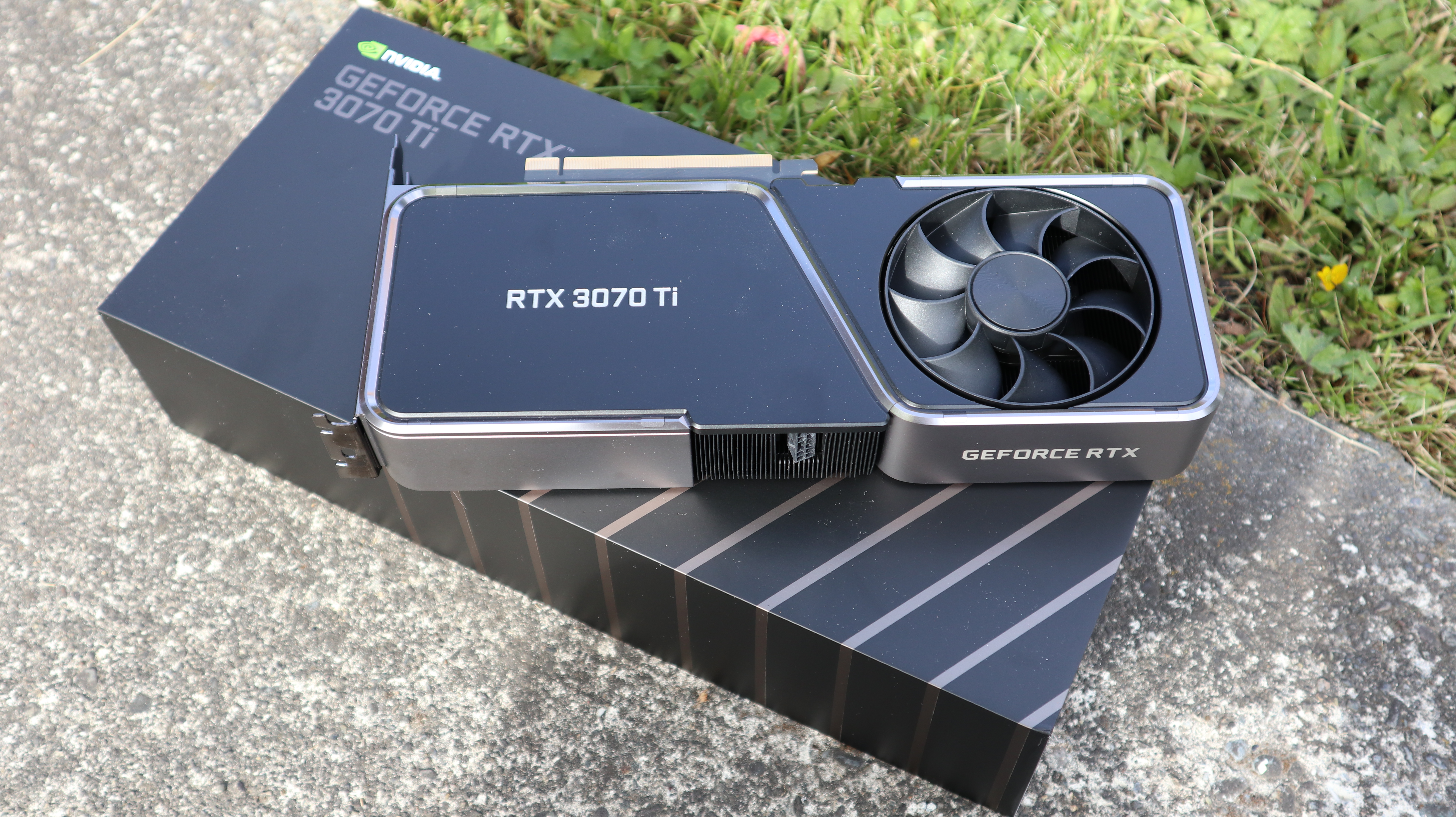 The Nvidia GeForce RTX 3070 Ti Founders Edition, going on sale this week for $599.Sam Machkovech
The Nvidia GeForce RTX 3070 Ti Founders Edition, going on sale this week for $599.Sam Machkovech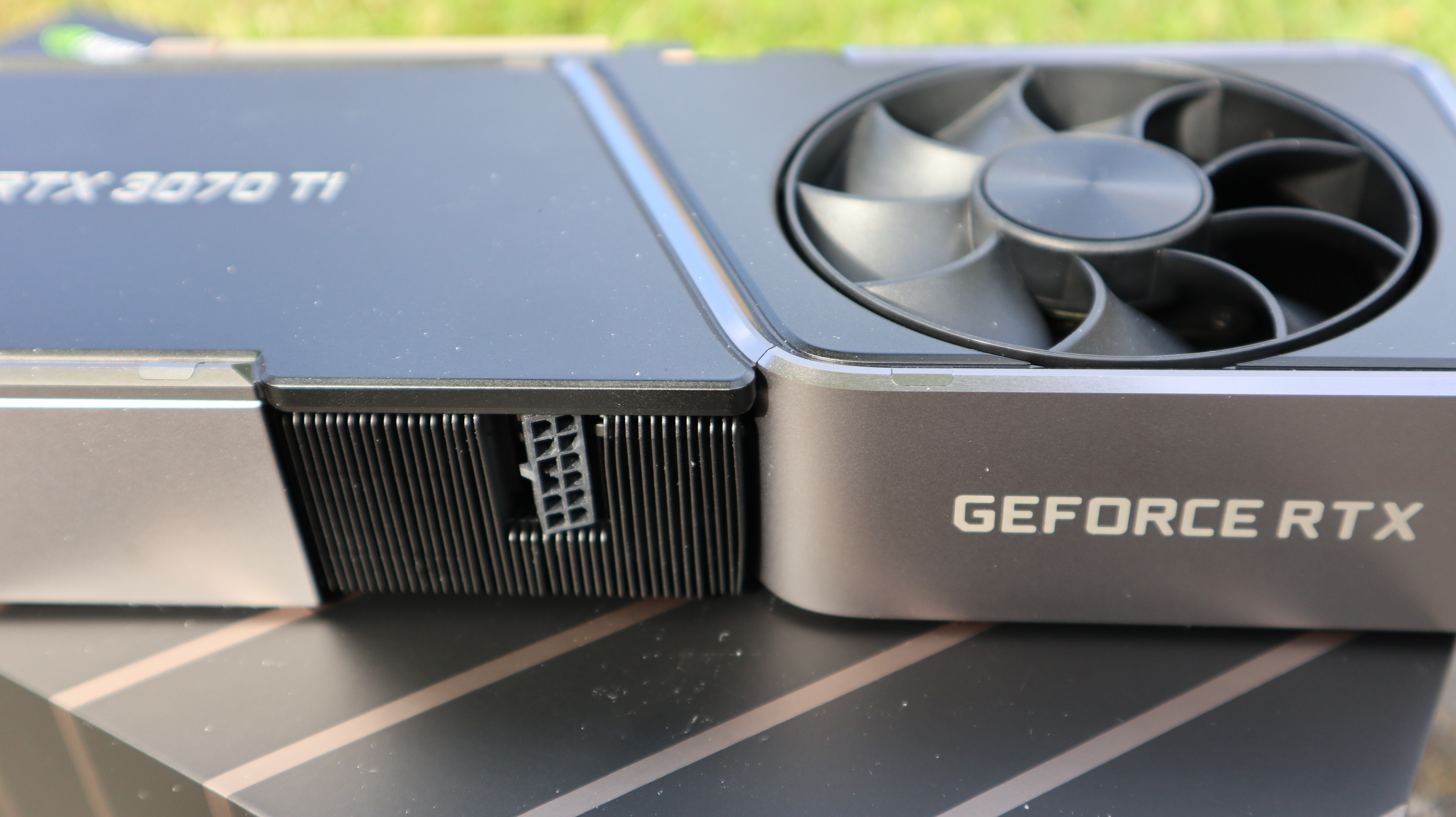 A zoom on Nvidia's proprietary power port, which you'll find on every RTX 3000-series GPU.Sam Machkovech
A zoom on Nvidia's proprietary power port, which you'll find on every RTX 3000-series GPU.Sam Machkovech Three DisplayPort ports, one HDMI 2.1 port.Sam Machkovech
Three DisplayPort ports, one HDMI 2.1 port.Sam Machkovech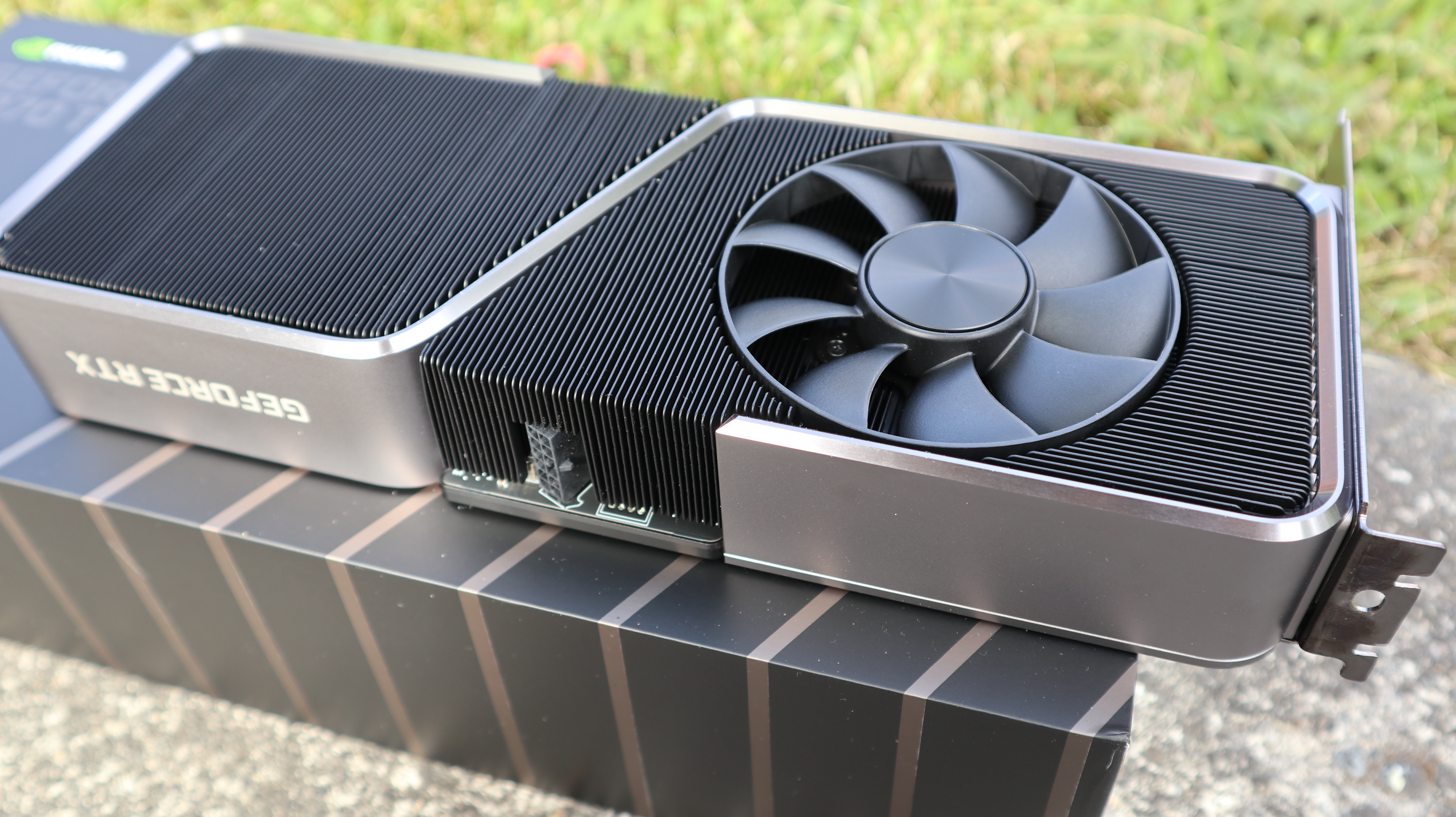 The RTX 3070 Ti uses a very 3080-like twin-fan system for intake and exhaust.Sam Machkovech
The RTX 3070 Ti uses a very 3080-like twin-fan system for intake and exhaust.Sam Machkovech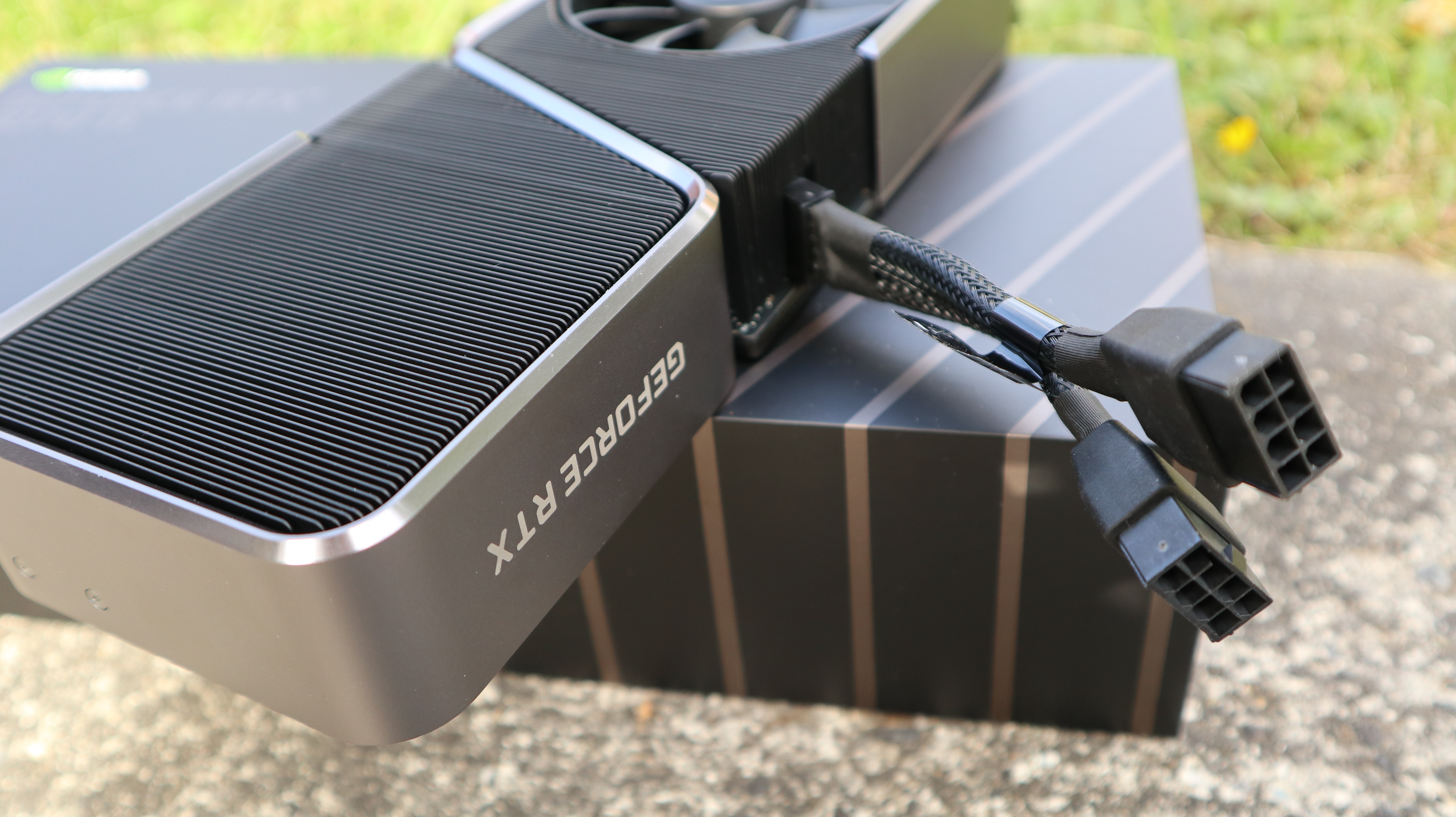 Adapter for standard PC power supplies.Sam Machkovech
Adapter for standard PC power supplies.Sam Machkovech
In a normal GPU marketplace, Nvidia's new GPU—the RTX 3070 Ti—would land either as a welcome jump or a power-per-watt disappointment. In the chip-shortage squeeze of 2021, however, both its biggest successes and shortcomings may slip by without much fanfare.
The company's RTX 3070 launched eight months ago at an MSRP of $499, and it did so at an incredibly efficient power-to-performance ratio. There's simply no better 220 W GPU on the market, as the RTX 3070 noticeably pulled ahead of the 200 W RTX 3060 Ti and AMD's 230 W RX 6700XT. That efficiency, unsurprisingly, isn't repeated with the new model released this week: the RTX 3070 Ti. This device's MSRP jumps 20 percent (to "$599," but mind the scare quotes), and its TDP screams ahead at 32 percent. We've been here before, of course. "Ti"-branded Nvidia cards aren't usually as power-efficient as their namesakes, and that's fine, especially if a mild $100 price jump yields a solid increase in performance.
But the RTX 3070 Ti spec sheet doesn't see Nvidia charge ahead in ways that might match the jump in wattage. And while the 3070 Ti's performance mostly increases across the board, the gains aren't in any way a revolution. That may be less about Nvidia's design prowess and more about squeezing this thing between the impressive duo of the RTX 3070 and RTX 3080 ($699) on an MSRP basis.
This new card's performance, unfortunately, doesn't land as evenly between those two GPUs.
Commonly around seven percent faster
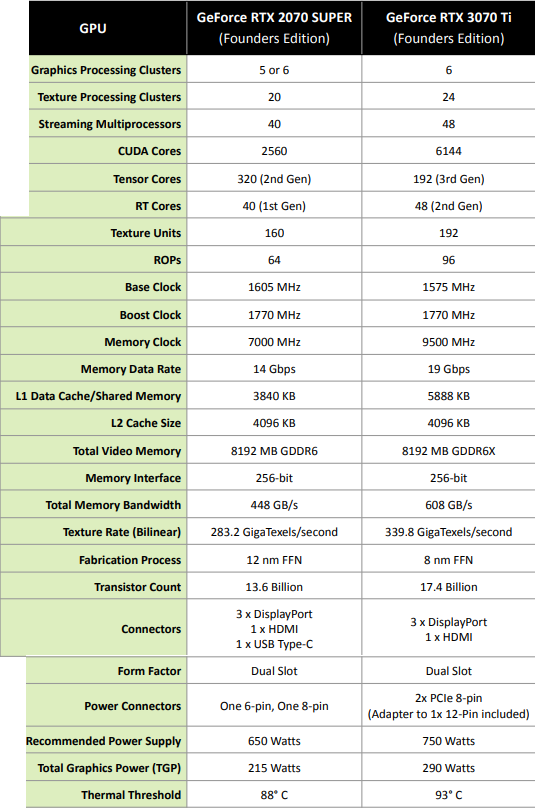 Specs for the 3070 Ti, which Nvidia puts next to the dated-in-comparison 2070 Ti.
Specs for the 3070 Ti, which Nvidia puts next to the dated-in-comparison 2070 Ti.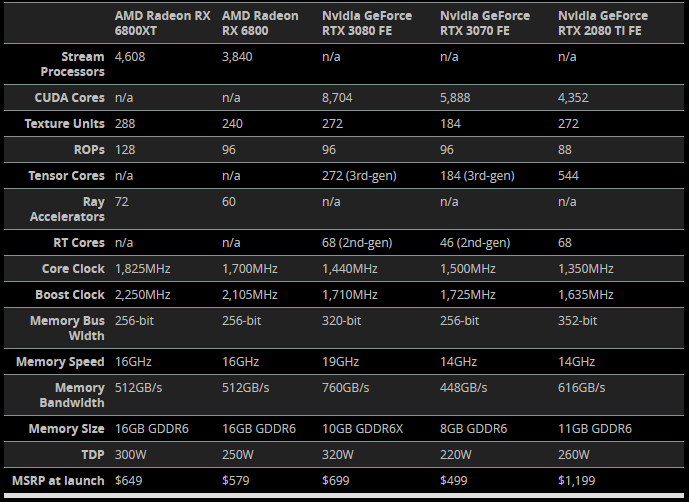 You'll probably prefer to place those specs next to the RTX 3080 and RTX 3070 to understand how Nvidia scaled existing supplies to create a new Ti product.
You'll probably prefer to place those specs next to the RTX 3080 and RTX 3070 to understand how Nvidia scaled existing supplies to create a new Ti product.
The new GPU's spec-sheet increases include an upgrade in VRAM technology from the 3070's GDDR6 to GDDR6X, and there are memory-spec upgrades to match—particularly a 26 percent jump in memory bandwidth. That's otherwise the same amount of VRAM as the 3070 (8GB). Meanwhile, the rest of the spec sheet is mostly a mild increase compared to the 3070 Ti's predecessor card. CUDA cores, texture units, tensor cores, and RT cores all increase an identical 4.16 percent over the RTX 3070. Boost clocks increase slightly less than that, and ROPs remain static.
Depending on the test, my RTX 3070 Ti review hardware can jump ahead as much as 14 percent over its older namesake, which is great (and likely the headline that Nvidia would prefer). But those gains are outliers. Just as often, test results land almost tied. The most common result is the 3070 Ti winning at closer to a seven percent increase over the 3070. The good news for the Ti, at least, is its more stable frame rates, as evidenced by the below benchmarks' solid "one percent low" stats.
The 3070 Ti is decidedly different from last week's RTX 3080 Ti, which had no problem proving itself to be an across-the-board upgrade over the cheaper RTX 3080. I measured the gains in those tests at 10 percent and up—though, again, the MSRP gap between those two cards was much higher ($500). And speaking of which: the RTX 3080 stomps far ahead of the RTX 3070 Ti, as the below charts make abundantly clear.
The 3070 Ti's average gain count over the 3070 applies whether ray tracing and DLSS are in the picture or not, with Cyberpunk 2077's version 1.2 standing out as an exception. In my custom benchmark of that CD Projekt Red title (which sees me walking forward for 60 seconds through the game's first bustling, open-air zone), I have recorded gains close to 40 percent over the RTX 3070, whether with DLSS on or off. Thanks to Cyberpunk 2077's notoriously buggy state, I do not recommend that GPU shoppers pin their ray-tracing performance hopes on that benchmark result. However, it does line up with my ability to run the game at a DLSS-boosted 1440p resolution, with ray tracing set to near-max, while enjoying surprisingly crisp imagery at 60 fps. Using the same "automatic" DLSS upscale to 1440p with the base RTX 3070 is slightly less stable and noticeably blurrier.
 That breakdown, of slight gains over the 3070 and considerable deficits behind the 3080, repeats over and over through the rest of these benchmarks.
That breakdown, of slight gains over the 3070 and considerable deficits behind the 3080, repeats over and over through the rest of these benchmarks. Ars' GPU testing rig includes an i7-8700K CPU, overclocked to 4.6 GHz, 32GB of DDR4-3000 RAM, and SSD drives. At its best, the RTX 3070 Ti slots into benchmarks exactly between the 3070 and 3080—just like its price.
Ars' GPU testing rig includes an i7-8700K CPU, overclocked to 4.6 GHz, 32GB of DDR4-3000 RAM, and SSD drives. At its best, the RTX 3070 Ti slots into benchmarks exactly between the 3070 and 3080—just like its price.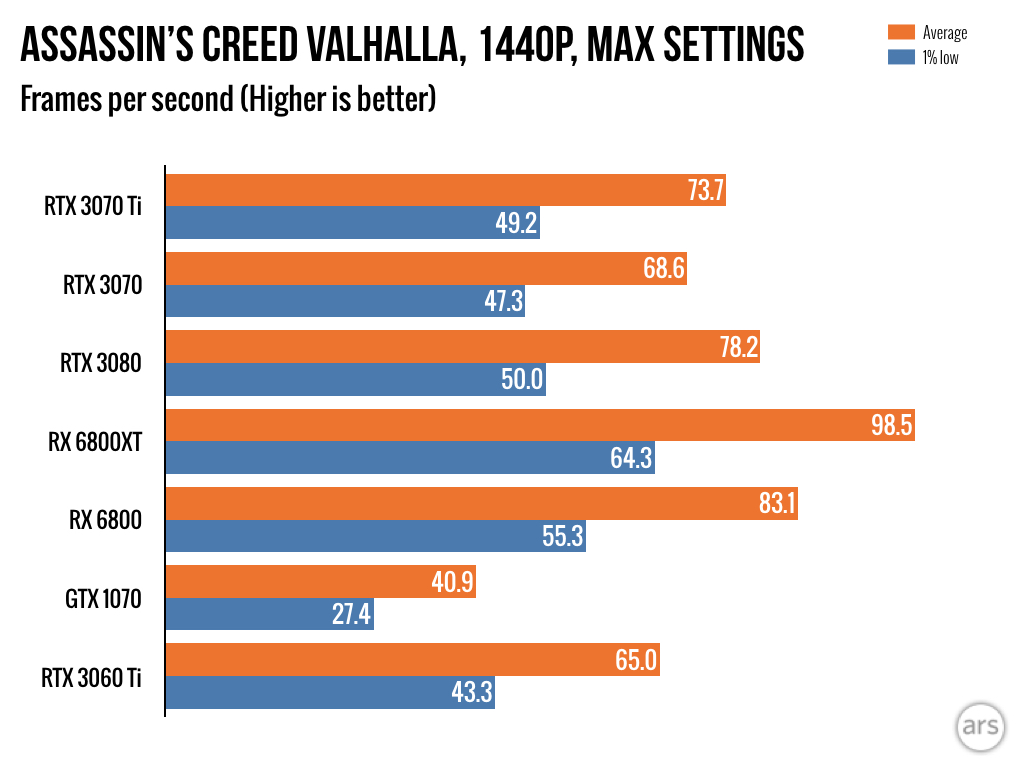 Pretty frequently, the 3070 Ti's RAM spec boosts don't do enough to fend off AMD's $600-ish options at 1440p resolution.
Pretty frequently, the 3070 Ti's RAM spec boosts don't do enough to fend off AMD's $600-ish options at 1440p resolution.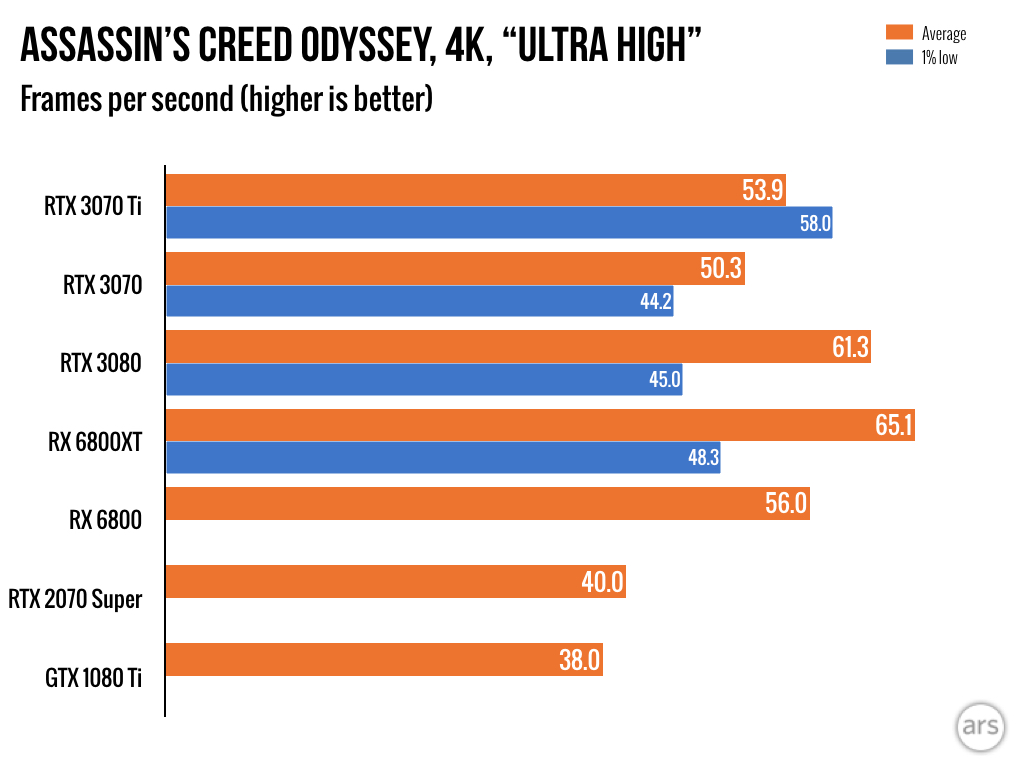 This less optimized game sees the 3070 Ti fall behind many other options on the list at 4K.
This less optimized game sees the 3070 Ti fall behind many other options on the list at 4K.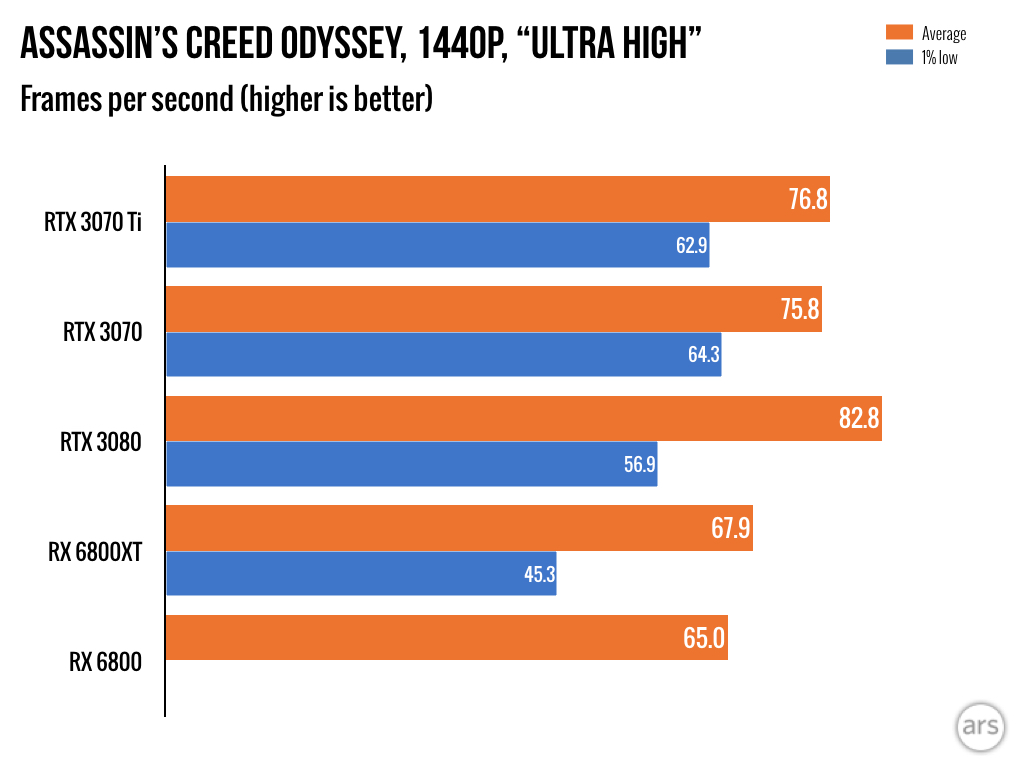 And it barely exceeds its namesake in this 1440p test.
And it barely exceeds its namesake in this 1440p test.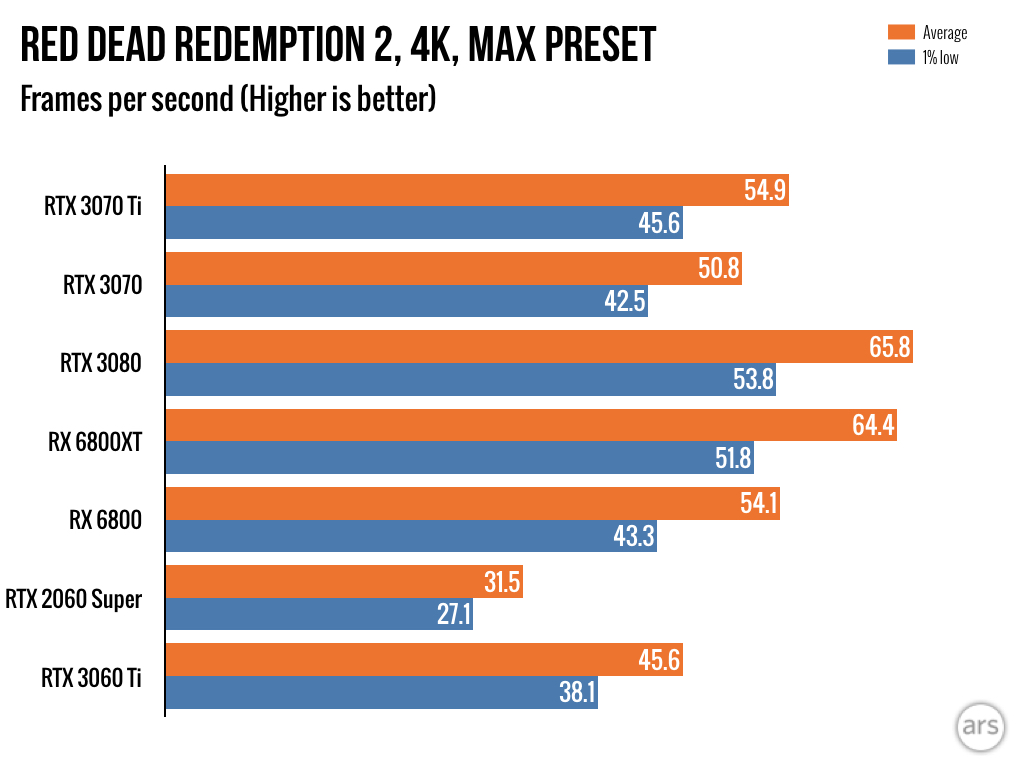 Fine-enough gains compared to the 3070, but the 3080 really pulls ahead here.
Fine-enough gains compared to the 3070, but the 3080 really pulls ahead here.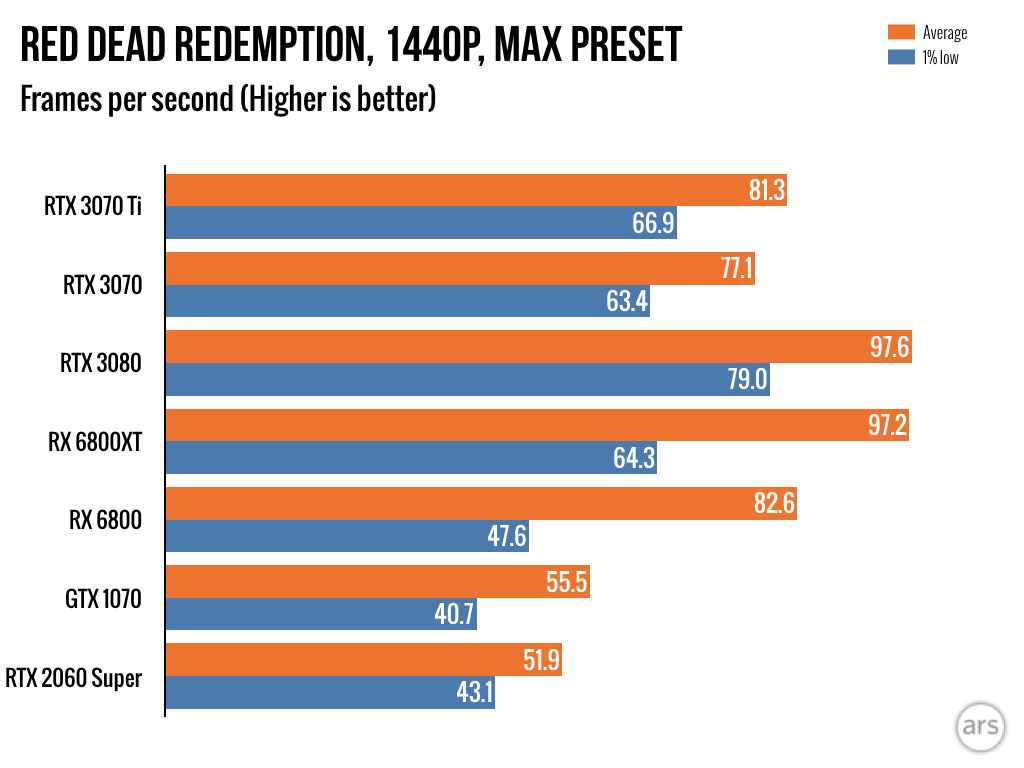 For a little more cash, you can really get some additional oomph from either the RTX 3080 or AMD's RX 6800XT.
For a little more cash, you can really get some additional oomph from either the RTX 3080 or AMD's RX 6800XT.
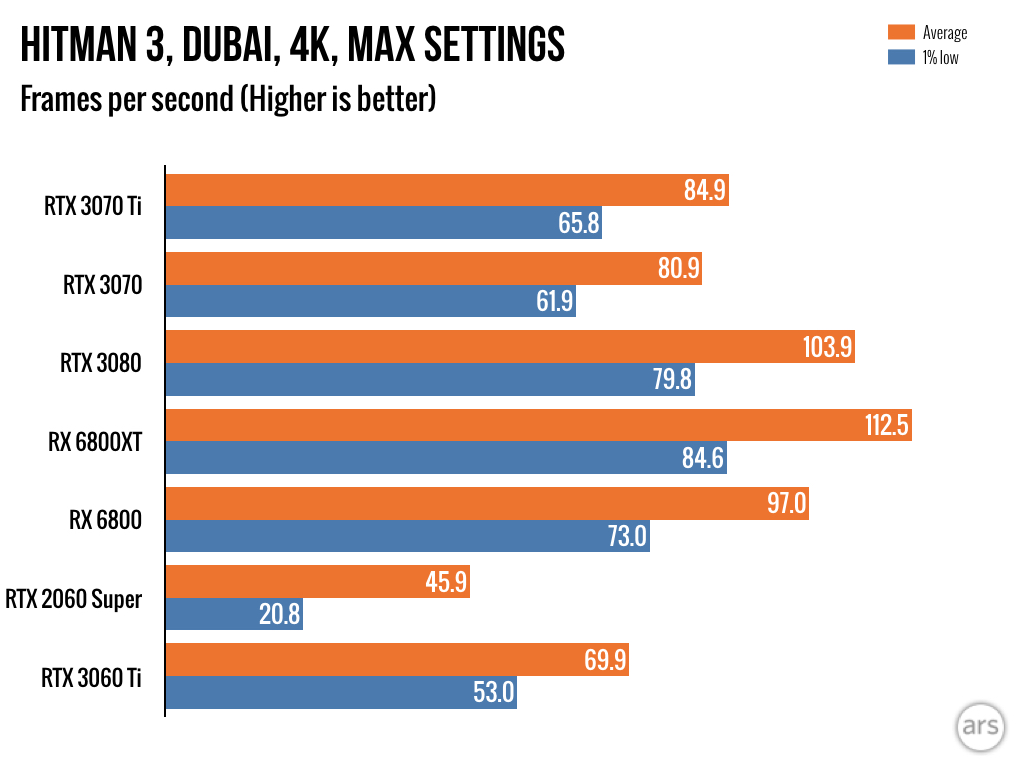 Shame that it's so hard to find RTX 3080 GPUs in the wild, because these gains over the 3070 Ti are considerable.
Shame that it's so hard to find RTX 3080 GPUs in the wild, because these gains over the 3070 Ti are considerable.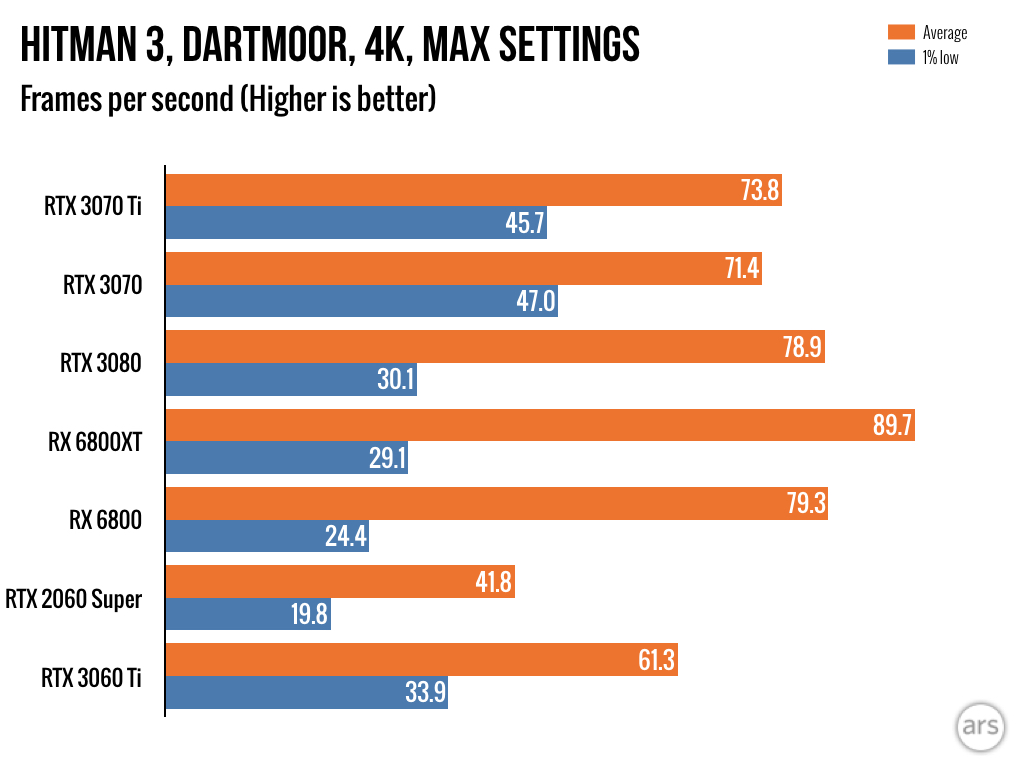 When it comes to CPU-intensive benchmarks, like this physics-filled Hitman 3 test, the AMD cards on the chart can really contend.
When it comes to CPU-intensive benchmarks, like this physics-filled Hitman 3 test, the AMD cards on the chart can really contend.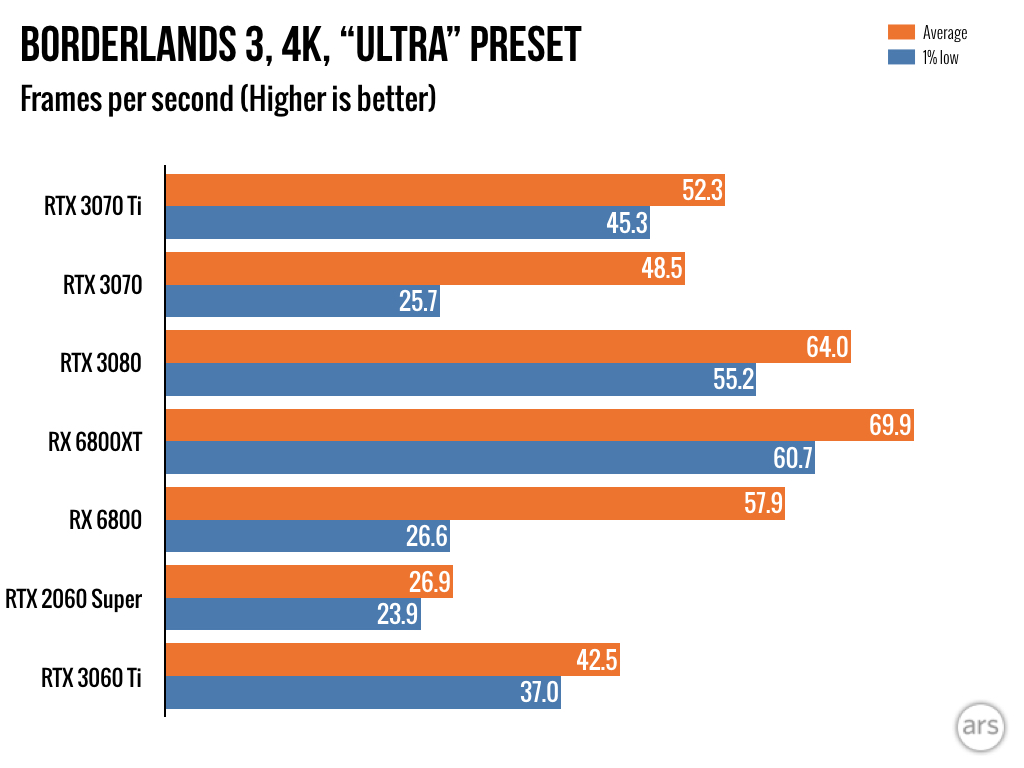 We're getting redundant here: slight gains over the 3070, but well short of the 3080.
We're getting redundant here: slight gains over the 3070, but well short of the 3080.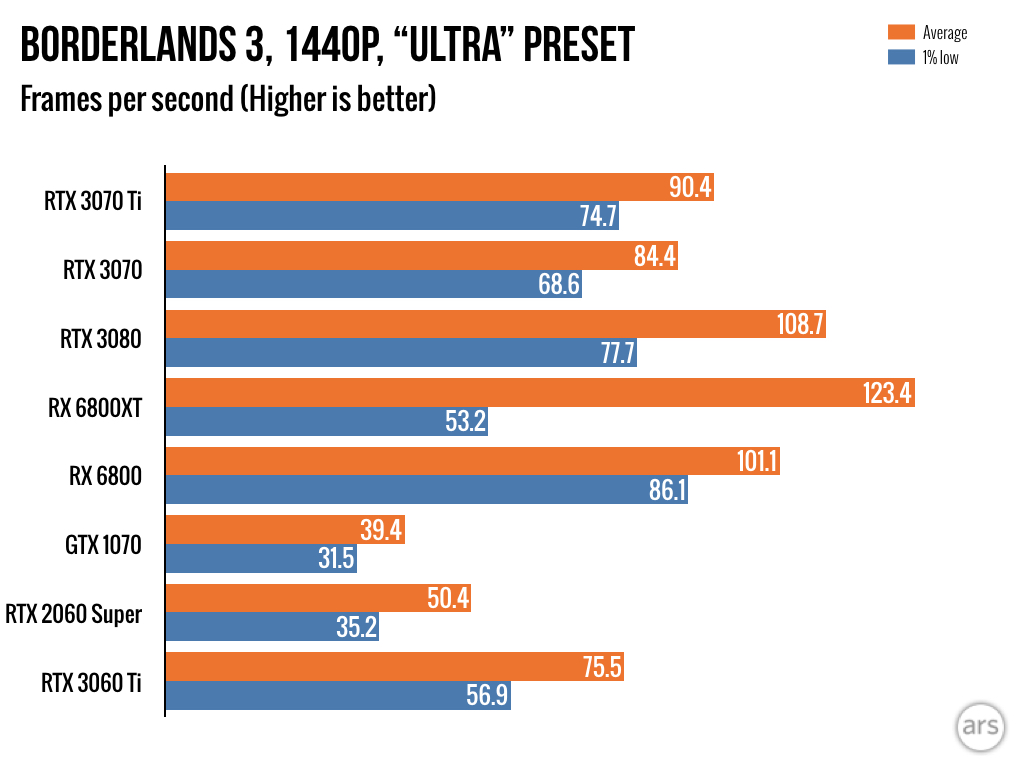
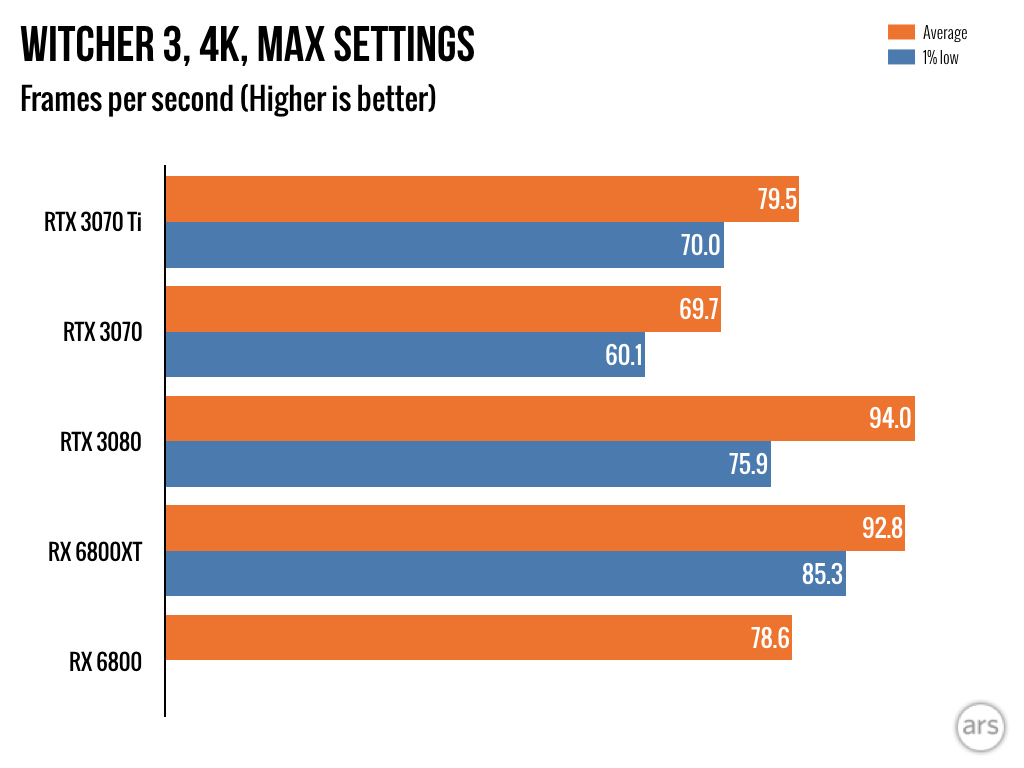
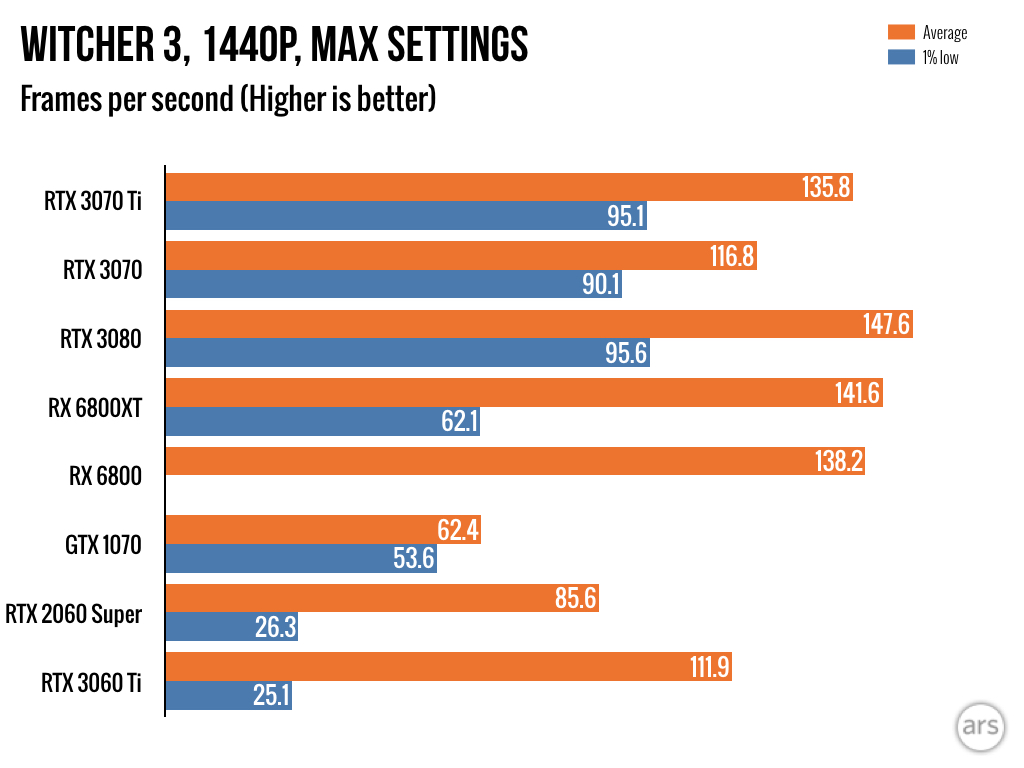
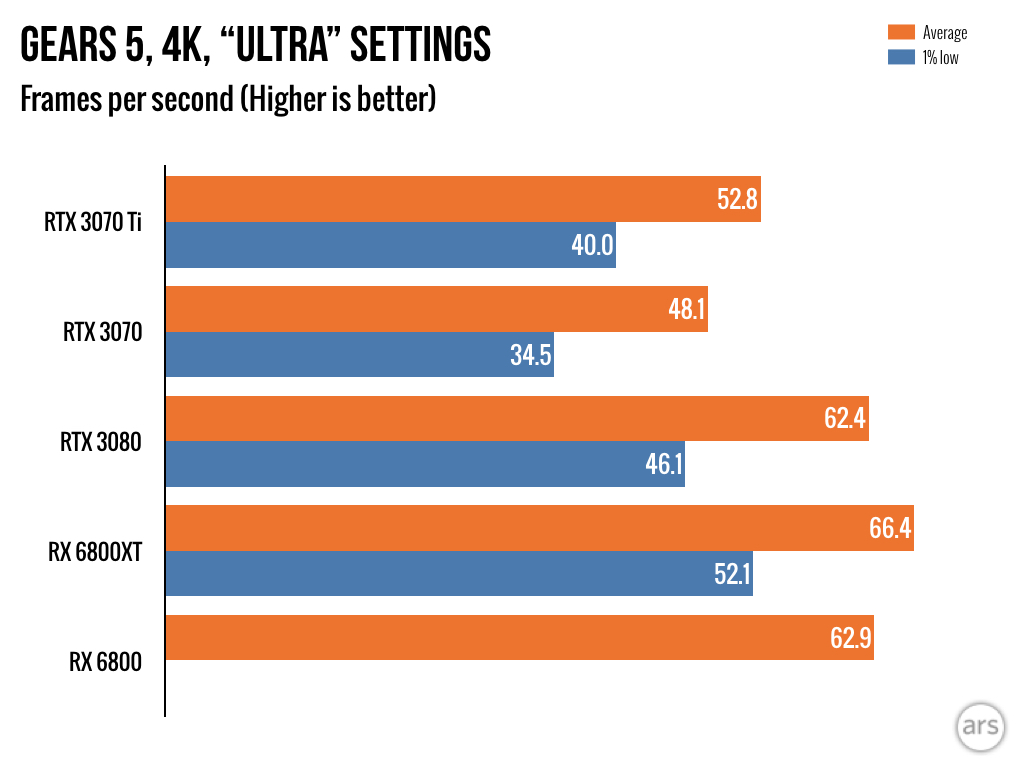
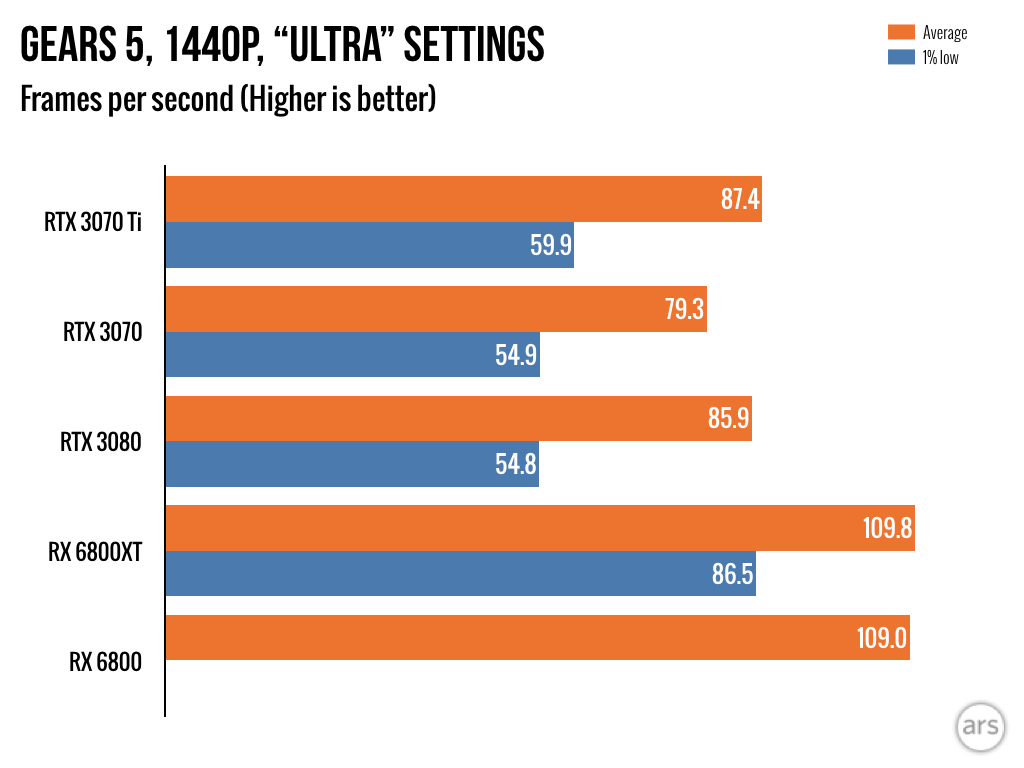 A wacky outlier of the RTX 3070 Ti pulling ahead of the RTX 3080, but not by a ton, so it arguably counts as a margin-of-error result.
A wacky outlier of the RTX 3070 Ti pulling ahead of the RTX 3080, but not by a ton, so it arguably counts as a margin-of-error result.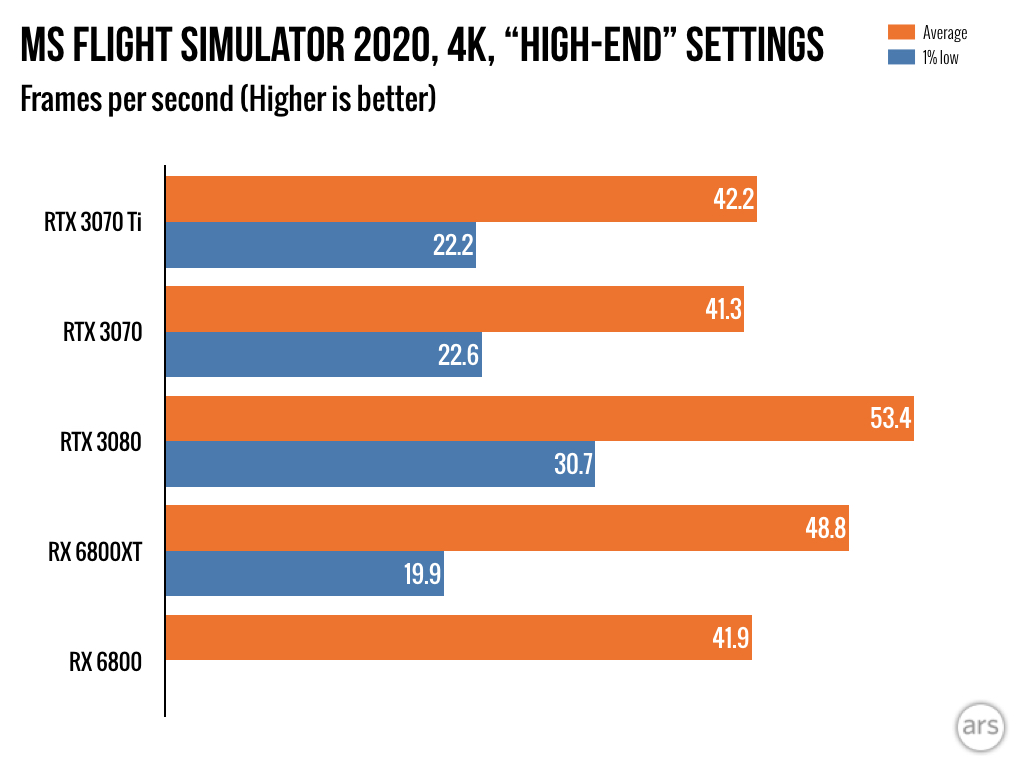 Please smother any MSFS test results in asterisks. I try to lock down as many variables as possible in my custom-made benchmark, but the game's performance still lands all over the map thanks to uneven CPU optimizations.
Please smother any MSFS test results in asterisks. I try to lock down as many variables as possible in my custom-made benchmark, but the game's performance still lands all over the map thanks to uneven CPU optimizations.
During my review process, I ran into bizarre RTX 3070 Ti behavior at first: its performance fell well behind the RTX 3070. This came without any apparent hardware noises, visual flickering, or other signs of losing the GPU lottery. During my initial tests, 3DMark's synthetic benchmarks did not suffer, suggesting an issue with Windows or drivers. Unhooking everything, reseating parts, and trying again didn't fix the problem.
As it turns out, my only solution was to enable, and then disable, the Windows 10 setting for "hardware-accelerated GPU scheduling." At first, this had me convinced that I needed to leave that setting enabled for the 3070 Ti to function properly. Eventually, after more trial and error than I cared to deal with, I learned that the HWAGS setting was ultimately not necessary (and it alternated between boosting and reducing GPU performance, depending on the game). In the end, I disabled it. There's a chance something else contributed to the 3070 Ti's initial weird performance, but I can no longer replicate the issue.
But in this GPU universe...
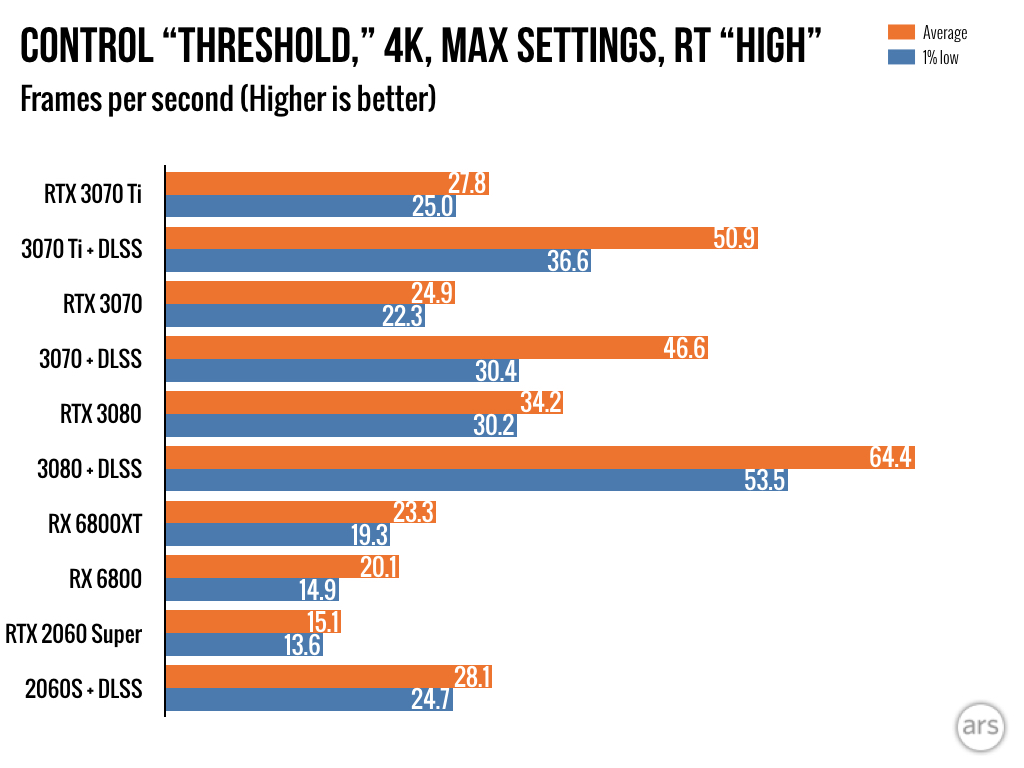 The incremental jump over the 3070 in ray tracing tests is nice, but here is where the RTX 3080 really pulls ahead, in pretty extreme fashion. (This is an RT-specific gallery of benchmarks.)
The incremental jump over the 3070 in ray tracing tests is nice, but here is where the RTX 3080 really pulls ahead, in pretty extreme fashion. (This is an RT-specific gallery of benchmarks.)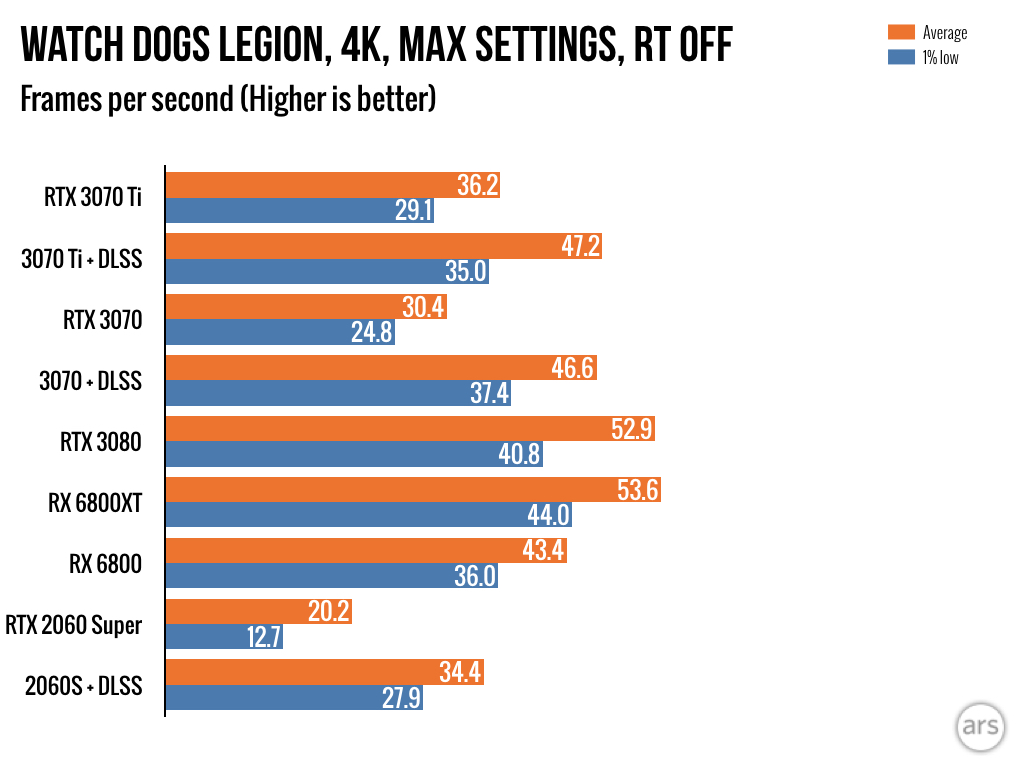 Results flatten out a bit more with RT disabled.
Results flatten out a bit more with RT disabled.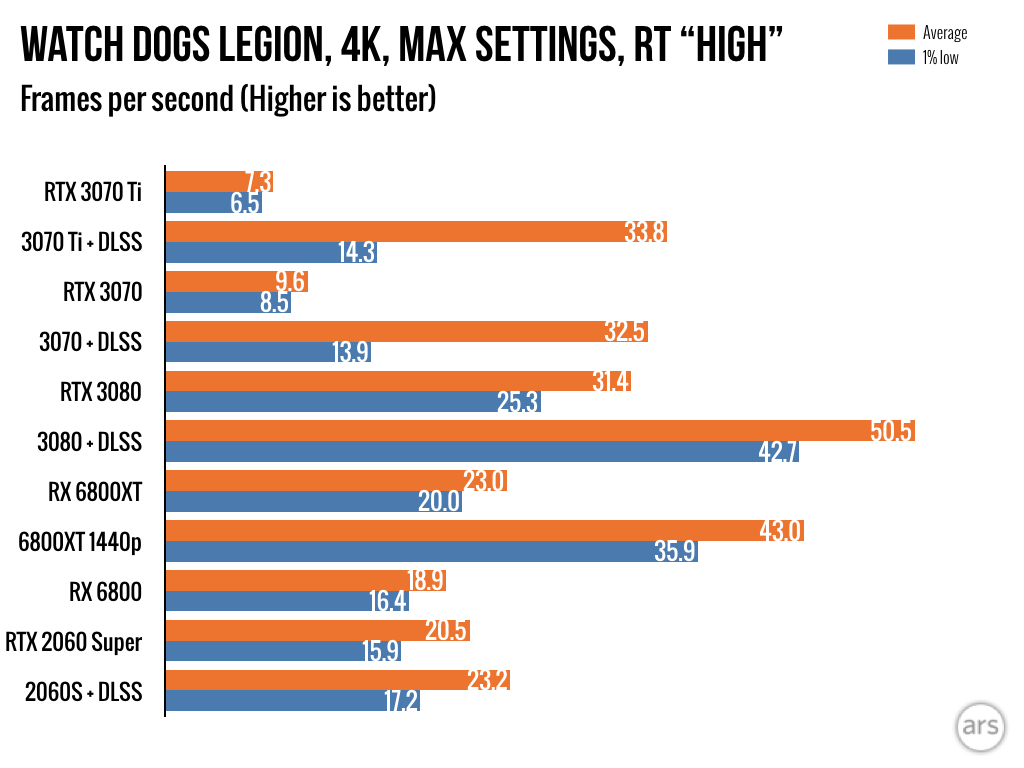 For only $100 more, the RTX 3080 absolutely trounces the 3070 Ti in this RT-intensive benchmark.
For only $100 more, the RTX 3080 absolutely trounces the 3070 Ti in this RT-intensive benchmark.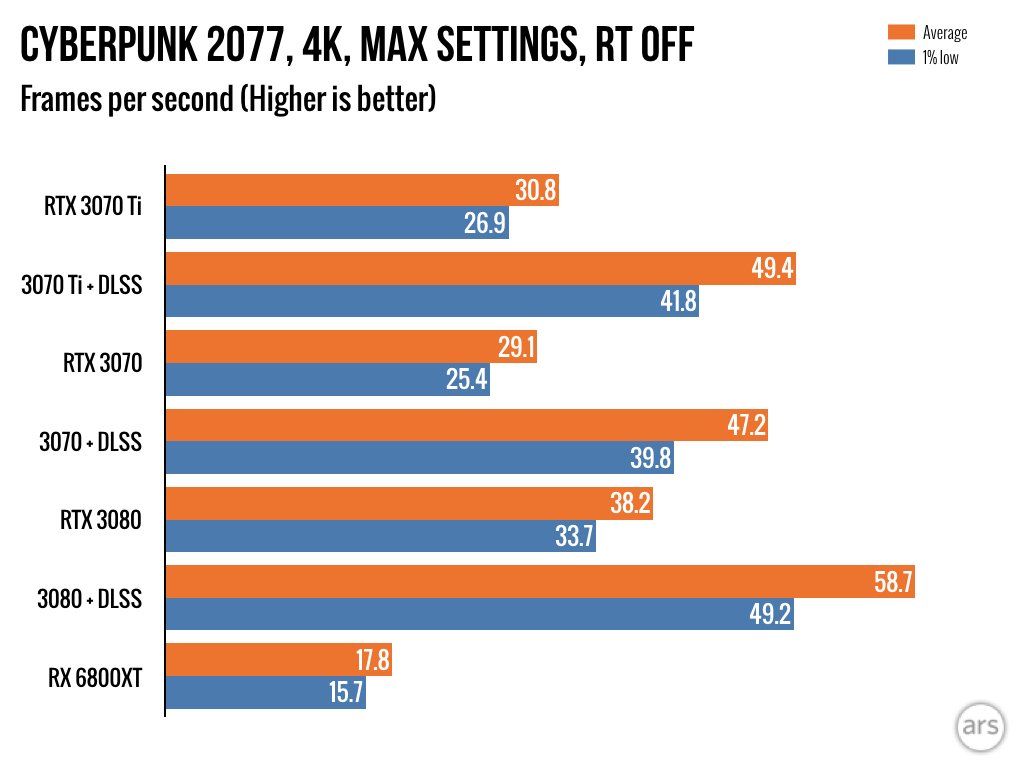 Relatively flat results compared to the 3070, when RT is disabled.
Relatively flat results compared to the 3070, when RT is disabled.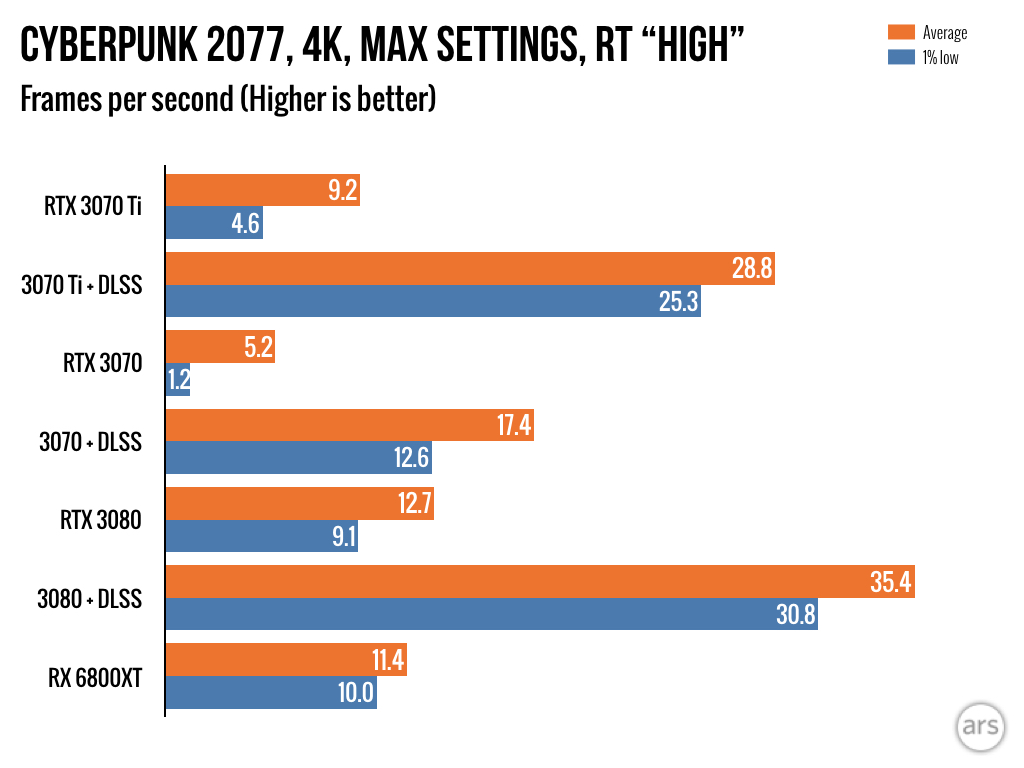 A rare case of the 3070 Ti really proving its power.
A rare case of the 3070 Ti really proving its power.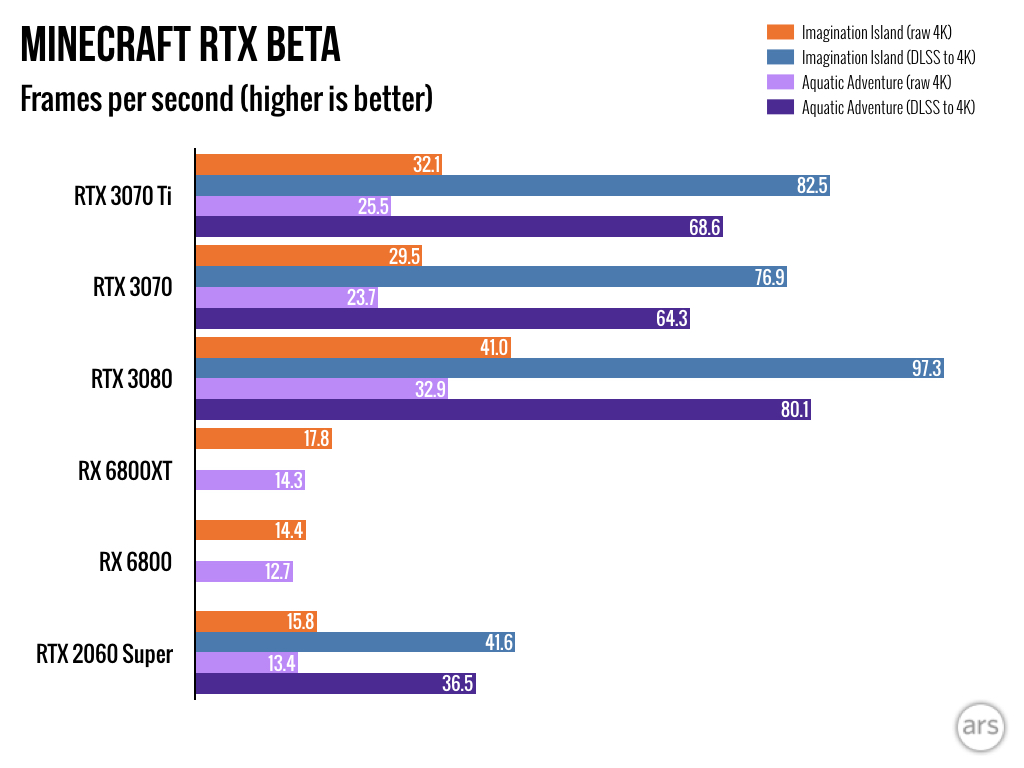 Minecraft RTX includes a few easily controllable ray tracing benchmark runs that I can repeat, and these results bear out as expected.
Minecraft RTX includes a few easily controllable ray tracing benchmark runs that I can repeat, and these results bear out as expected.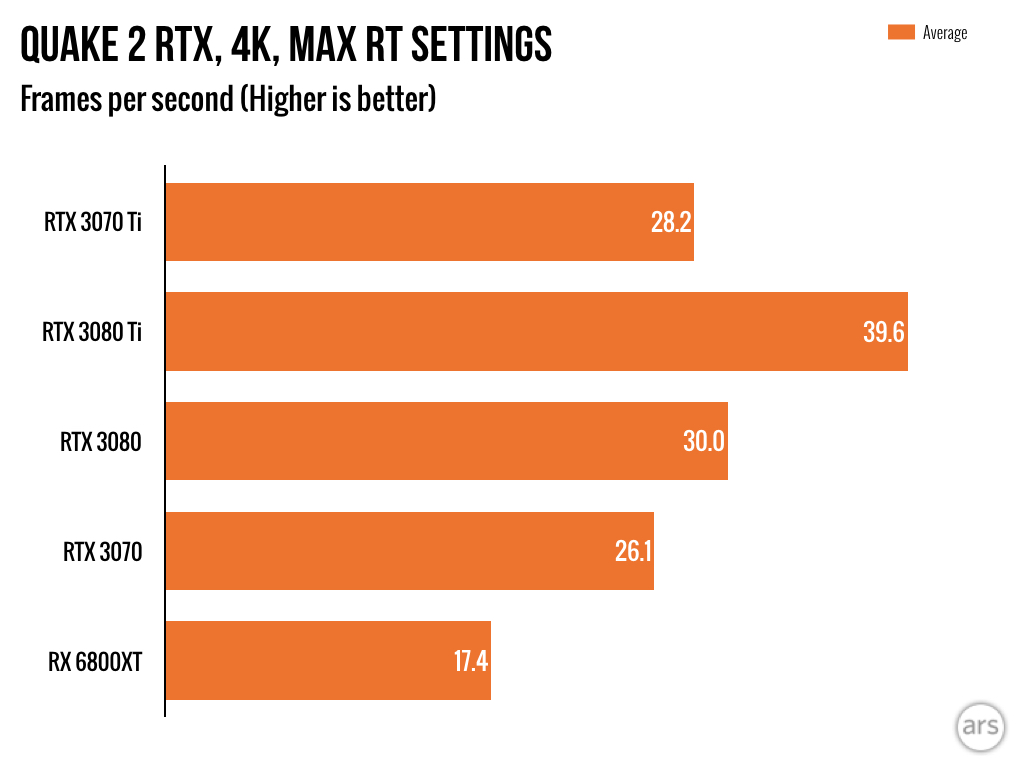 You'll likely want to scale this game down to 1440p for greater ray tracing performance, but pushing it at 4K at least lets us isolate GPU-specific differences. Measure the percentages, not the frames, in this brutal benchmark.
You'll likely want to scale this game down to 1440p for greater ray tracing performance, but pushing it at 4K at least lets us isolate GPU-specific differences. Measure the percentages, not the frames, in this brutal benchmark.
The RTX 3070 and 3070 Ti don't live in isolation, and the newer card's mostly meager increases may look fantastic to AMD loyalists who have purchased an RDNA 2-series GPU in the past year. As you can see in the above spec tables, the RX 6800, which debuted last November at an MSRP of $579, absolutely contends with Nvidia's similarly priced RTX 3070 Ti. Meanwhile, $70 more in MSRP gets you some serious gains in the form of AMD's RX 6800XT. And depending on what universe you live in, your choice may boil down to whether you believe in the promise of ray tracing and Nvidia's proprietary DLSS. AMD simply can't compete with that yet.
But I mention "universes" because, as I have typed a lot as of late, this GPU universe is largely defined by chip shortages and auction prices. Until GPU prices and supply stabilize, Nvidia can admittedly call a mulligan on this GPU's disappointments—and that's a pretty loud indication that Nvidia has entered the not-so-fast lane for the time being. What's the point of aggressively competing with updated SKUs when a boilerplate release can turn a Best Buy parking lot into a BTS-like crowd frenzy?
Still, if you're eager to upgrade your GPU, are somehow able to snap up an RTX 3070 Ti at a normal retail price, and can stomach a VRAM maximum of 8GB, you can expect a moderately future-proofed 1440p performer, right around the same performance level as the 3070. Let's be clear—whether it exceeds or meets the original 3070, the 3070 Ti is still doing significant work, whether by leveraging Nvidia's ray tracing-specific cores or by supporting DLSS as an upscaling champion. (AMD's new rival standard doesn't look like it's going to come close any time soon.)
The same cannot be said for 4K performance. That 8GB VRAM cap will dash your dreams of the highest-res textures. And the rest of the spec sheet doesn't necessarily scale to raw 4K rasterization, unless you play with settings or luck out with your favorite game(s) supporting the largely successful DLSS standard.
If Ars' comment sections are any indication, readers had been holding out hope that an eventual "3070 Ti" would mostly copy the original RTX 3070's spec sheet, only with more VRAM. The 3080 Ti kinda-sorta delivered in that respect by jumping from its predecessor's 10GB of VRAM to 12GB. But the 3070 Ti instead insists that its upgrade potential makes more sense with faster VRAM, not more. In some test results, that bears out. But that decision arguably does not pan out in enough results—and certainly not when compared to how much an additional $100 nets you from an RTX 3080.
Listing image by Sam Machkovech
https://ift.tt/3w7aGkc
Bagikan Berita Ini














0 Response to "RTX 3070 Ti review: Nvidia leaves the GPU fast lane (for now) - Ars Technica"
Post a Comment